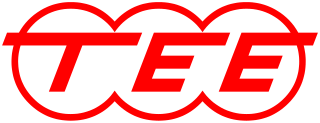
The Trans Europ Express, or Trans-Europe Express (TEE), was an international first-class railway service in western and central Europe that was founded in 1957 and ceased in 1995. At the height of its operations, in 1974, the TEE network comprised 45 trains, connecting 130 different cities, from Spain in the west to Austria in the east, and from Denmark to Southern Italy.

The Höllentalbahn is a railway line that partially runs through the Höllental valley in the Black Forest of Germany. The line connects Freiburg im Breisgau with Donaueschingen, a distance of 74.7 km (46.4 mi).
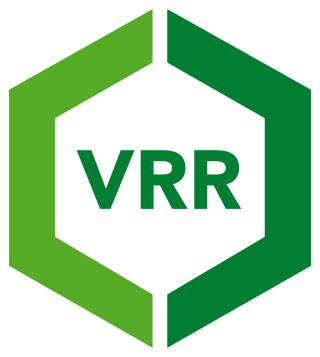
The Verkehrsverbund Rhein-Ruhr, abbreviated VRR, is a public transport association (Verkehrsverbund) in the German state of North Rhine-Westphalia. It covers most of the Ruhr area, as well as neighbouring parts of the Lower Rhine region, including Düsseldorf and thus large parts of the Rhine-Ruhr conurbation. It was founded on 1 January 1980, and is Europe’s largest body of such kind, covering an area of some 5,000 km2 (1,900 sq mi) with more than 7.8 million inhabitants, spanning as far as Dorsten in the north, Dortmund in the east, Langenfeld in the south, and Mönchengladbach and the Dutch border in the west.
The different railway companies in Germany have used various schemes to classify their rolling stock.

The Hanover–Würzburg high-speed railway is a double-track, electrified high-speed railway between Hanover and Würzburg in Germany, 327 km (203 mi) in length. The line, built between 1973 and 1991, was the longest contiguous new project constructed by Deutsche Bundesbahn. The total costs were almost DM 11.9 billion.

City Night Line, abbreviated CNL, was a train category of German railway company Deutsche Bahn for overnight passenger train services between Germany and neighbouring European countries. In late 2015, Deutsche Bahn announced that it planned to terminate all night train services in December 2016, and this plan was implemented on 11 December 2016. The service on some CNL routes was replaced by ÖBB Nightjet services.

Ahrensfelde station is a station serving regional and S-Bahn services in the Berlin borough of Marzahn-Hellersdorf. It is located on the border of Berlin just outside the municipality of Ahrensfelde, which is in the state of Brandenburg. The station has three platform edges, one side platform for the S-Bahn, and an island platform for Regionalbahn and S-Bahn services.

The Uelzen–Langwedel railway runs through the Lüneburg Heath in north Germany in an east-west direction. The line became known as part of the so-called America Line.
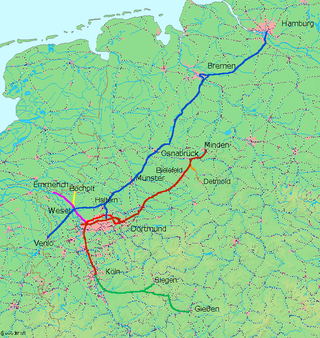
The Hamm–Minden Railway is an important and historically significant railway in Germany. It is completely quadruple track. It is a major axis for long distance passenger and freight trains between the Ruhr and the north and east of Germany. It is the part of the trunk line built by the Cologne-Minden Railway Company from Köln Deutz to Minden. It was opened in 1847 and has been modernized and developed several times since then.

The Oberhausen–Arnhem railway is a two-track, electrified main line railway running close to the lower Rhine from Oberhausen via Wesel, Emmerich and the German–Dutch border to Arnhem and forms part of the line between the Ruhr and Amsterdam. The line was opened by the Cologne-Minden Railway Company in 1856 and is one of the oldest lines in Germany.

A clock-face schedule, also cyclic schedule, is a timetable system under which public transport services run at consistent intervals, as opposed to a timetable that is purely driven by demand and has irregular headways. The name derives from the fact that departures take place at the same time or times during the day. For example, services with a half-hourly frequency might leave at 5:15, 5:45, 6:15, 6:45, 7:15, 7:45 etc.

The Rhein-Express is a Regional-Express service, which generally follows the Rhine river. It runs daily every hour from 5 am to 9 pm from Wesel via Oberhausen, Duisburg, Düsseldorf, Cologne, Bonn, Remagen and Andernach to Koblenz, in the German states of North Rhine-Westphalia and Rhineland-Palatinate. It is the fourth-most used regional express line in the VRR network with approximately 48,000 passengers a day.
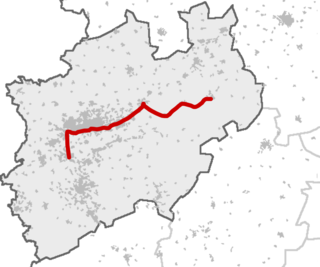
The Rhein-Hellweg-Express is a Regional-Express service in the German state of North Rhine-Westphalia (NRW), running from Kassel via Dortmund, Bochum, Essen, Duisburg and Düsseldorf Airport to Düsseldorf Hbf. It is named after the Rhine and the Westphalian Hellweg. The line is part of the Rhine-Ruhr Express (RRX) network and is operated by National Express.

The Herbertingen–Isny railway is a single-track railway in the German state of Baden-Württemberg. The Leutkirch–Kißlegg section is part of an upgraded long-distance route between Munich and Lindau, which was completed in 2020.
The Friedberg–Hanau railway is a 32.2 km long double-track, electrified mainline in the German state of Hesse. It connects Friedberg and Hanau. The line has the timetable number of 633 and it is integrated in the Rhein-Main-Verkehrsverbund as Regionalbahn service RB 49.

Tutzing station is currently the only station of the Bavarian town of Tutzing and a station on the Munich S-Bahn. It is classified by Deutsche Bahn as a category 4 station and has three platform tracks. It is served daily by about 130 trains operated by Deutsche Bahn, including 50 S-Bahn trains. Tutzing station is located on the Munich–Garmisch-Partenkirchen railway and is the beginning of the Kochelsee Railway to Kochel.

Coesfeld Station (Westphalia) is the main railway station of the town of Coesfeld and an important transport hub in western Münsterland in the German state of North Rhine-Westphalia. It is a junction station on the Dortmund–Enschede, Essen-Coesfeld and Empel-Rees–Münster lines.

The Gelsenkirchen-Buer Nord–Marl Lippe railway is an approximately 17 kilometre-long, electrified and predominantly single-track main line railway in the north of the Ruhr district of the German state of North Rhine-Westphalia. It connects Gelsenkirchen-Buer Nord station on the Oberhausen-Osterfeld Süd–Hamm railway with Marl Lippe junction on the Wanne-Eickel–Hamburg railway. The route is included in the list lines showing local speeds under the VzG route number of 2252. As the railway was planned by the Ruhr coal district association as traffic axis (Verkehrsband) No. 9, it is also colloquially called V9.
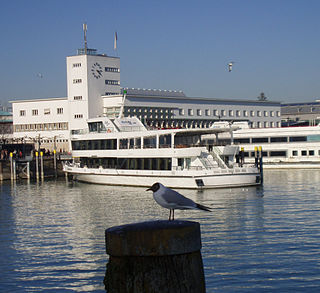
The Friedrichshafen Stadt–Friedrichshafen Hafen railway is a standard gauge and non-electrified railway line in the city of Friedrichshafen in the German state of Baden-Württemberg. It connects the town station with the port station. The 816 metre-long branch line has its own VzG route number, 4531, although operationally it is a connection between two parts of the same station.
















